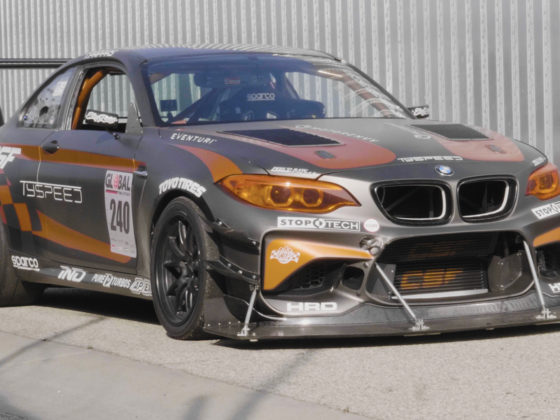
Halfway down their length, the primary tubes step up from 1 7/8″ in diameter to 2″. The step helps reduce reversion and gives a broader powerband.

The ASP header features a merged collector and a megaphone with a reverse cone. The megaphone gives a broader powerband and the reverse cone helps reduce the power fall off past the power peak.

A merged collector smoothly blends all the primaries together. It not only flows better for more peak power but also acts as an extension of the primary tubes, giving a broader powerband and more top end together. A merged collector works way better than the traditional box collector.

At the end of the megaphone is a V-Band for easy attachment to your exhaust system. Overall the ASP header has all of the features of a custom super expensive race header for a reasonable price.

For engine management, we turned to Hondata for their K-Pro ECU. The K-Pro is a 2002-2004 OEM ECU from a RSX Type S manual transmission with a K20A2 engine that has been modified by Hondata to be user-programmable. For a 2005-2006 RSX like our car, an adaptor harness needs to be used but the ECU will bolt into the stock location. The K-Pro is fully user programmable and it also data logs what the stock sensors are doing.
Stay tuned as we assemble our all-around killer K24/K20 hybrid and drop it into our restored RSX!
For more on our Project DC5 RSX check out here!
Sources
Hondata
Drag Cartel
Supertech Performance
K-Tuned
DeatschWerks
Advanced Street Performance
PRL Motorsports
Earls Performance Plumbing
JE Pistons
K1 Technologies
King Bearings
4-Piston Racing
ARP
Fluidampr
McLeod




10 comments
I don’t understand why that collector necks down before the V-band, the “reverse cone”. I don’t get how it would not induce a back pulse, granted turbulent flow physics is not my domain.
At what point in a build would you consider going to individual lambda versus the one? Would there be any gain without ITBs?
Okay well I went studying a bit on reverse cones and it seems they do generate a backpulse but in a certain RPM range that backpulse turns into a negative pressure backpulse (because of the megaphone shape) that helps suck in fresh air during valve overlap. The bad side seems to be that it has a negative impact on low RPM torque and leaves a torque dead zone during the transition into that negative pressure backpulse. That dead zone seems to be minimised by 4-2-1 headers since the second pulse mitigates the first one during that transition period… This just confirms that turbulent air is not my domain, I’ll let wizards deal with it.
In my testing, the reverse cone reduces power drop off after the peak as I said in the article.
That would make sense, the pulse sucks air in during valve overlap when your piston is near TDC where it’s not doing anything, so that pulse is virtually lengthening your intake duration.
The article I read was about reverse cone exhausts on MotoGP bikes with high RPM NA 4 where they are used to broaden the usable RPM range.
Good thing ASP only doesn’t do BP headers, I need to spend on a new winter car instead.
I don’t like complications and additional stuff on cars. Maybe for dyno headers, I might do that on a well-funded engine development program. Once you start paying for stuff out of your own pocket, you idea on how you ought to do things changes.
Curious to see how much timing you will be able to run on 91
*their magic
From previous experience with this engine, in the low 20’s.
Wow, that’s it eh? I guess with the cam timing and (maybe) small combustion chamber volume of these engines you do not need to run a significant amount of advance? I have a lot yet to learn on K tuning.
small bore too.
I have a good price on a 2012 SI, but it looks like the Z block is way less popular than the A for tuning, is it just a production quantity thing or is there some downside to the Zs that I don’t know about, I could just drop on a 20A head and keep my stock 11:1 bottom end?
Is anything specially bad on the FG that would need to be addressed for autocross? Like the EP steering/suspension geometry problems?